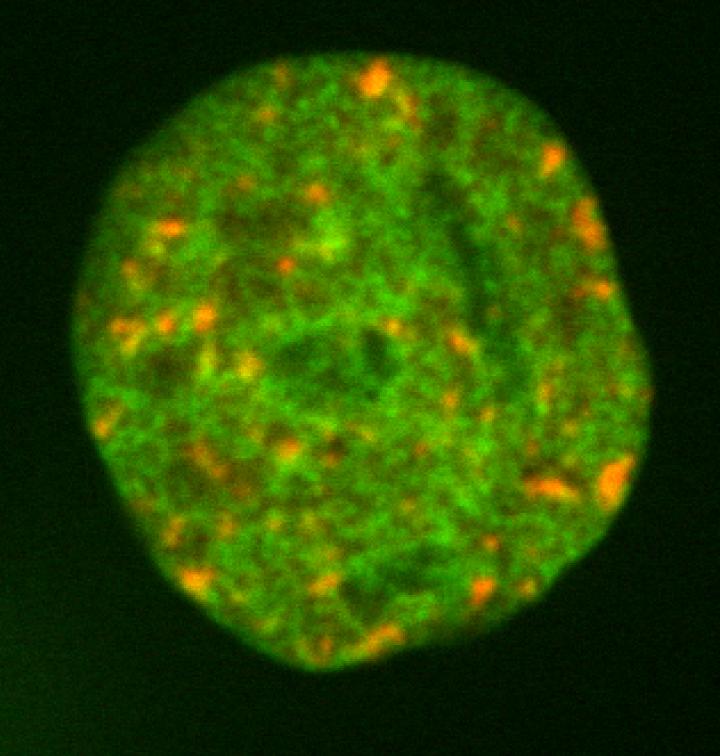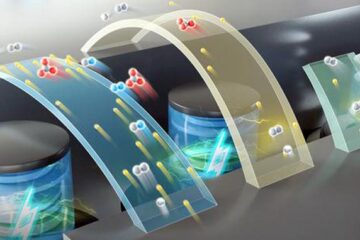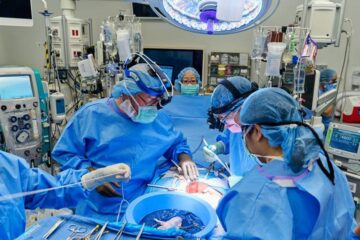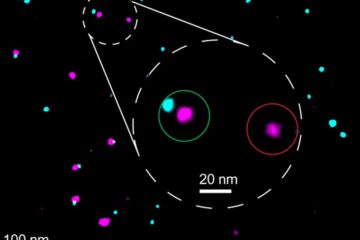What does DNA's repair shop look like? New research identifies the tools

Human nucleus with fluorescently labeled genome (green) and sites of induced double stranded DNA breaks (red). Credit: Jonah A. Eaton and Alexandra Zidovska, Department of Physics, New York University. Usage Restrictions: In conjunction with this study only
“Our findings show that a DNA repair process is very robust, engineered through intricate structural and dynamical signatures where breaks occur,” explains Alexandra Zidovska, an assistant professor in New York University's Department of Physics and the senior author of the study, which appears in Biophysical Journal.
“This knowledge can help us understand human genome in both healthy and disease-stricken states–and potentially offer a pathway for enhancing cancer diagnosis and therapy.”
The human genome consists, remarkably, of two meters of DNA molecules packed inside a cell nucleus, which is ten micrometers in diameter. The proper packing of the genome is critical for its healthy biological function such as gene expression, genome duplication, and DNA repair.
However, both the genome's structure and function are highly sensitive to DNA damage, which can range from chemical change to the DNA molecule to full break of DNA's well-known double helix.
Yet, such harm is not unusual. In fact, the human genome experiences about thousand DNA damage events every day, which can occur naturally or due to the external factors such as chemicals or UV radiation (e.g. sunlight).
But, if left unrepaired, DNA damage can have devastating consequences for the cell, note Zidovska and study co-author Jonah Eaton, NYU doctoral student.
For example, an unrepaired DNA double strand break can lead to cell death or cancer; therefore, DNA repair mechanisms are crucial for cellular health and survival.
In the Biophysical Journal study, the scientists examined the formation, behavior, and motion of DNA double strand breaks in the human genome. To do so, they chemically induced DNA breaks inside of live human cells, tracing these breaks using fluorescent markers.
With the help of microscopy and machine learning technologies, they followed the motion of the DNA breaks and genome in both space and time.
In their analysis of more than 20,000 DNA breaks in over 600 cells, the researchers found that genome tends to change the nature of its packing around a DNA break.
“This new packing state for DNA undergoing repair, is unlike any packing state found for a healthy DNA,” says Zidovska. “Around a DNA break we find that DNA becomes denser than its surrounding DNA, forming a small island of highly condensed DNA immersed in the sea of uncondensed DNA.”
In addition, they observed that DNA breaks also move in a unique way–different from that of undamaged parts of genome. The islands of condensed DNA around a DNA break move faster than do healthy DNA, yet the mobility of such islands strongly depends on their size.
“The human genome is constantly exposed to events that damage the DNA molecule,” notes Zidovska. “The cell has robust repair processes that work to eliminate such damage before it can give cause to cancer or other diseases. Now we have a better understanding of how a DNA break behaves differently than the undamaged DNA, which allows us not only to gain insight into these repair processes but also inform our efforts in cancer diagnosis and therapy.”
###
This research was supported by grants from the National Institutes of Health (R00-GM104152) and the National Science Foundation (CAREER PHY-1554880, CMMI-1762506).
Media Contact
All latest news from the category: Life Sciences and Chemistry
Articles and reports from the Life Sciences and chemistry area deal with applied and basic research into modern biology, chemistry and human medicine.
Valuable information can be found on a range of life sciences fields including bacteriology, biochemistry, bionics, bioinformatics, biophysics, biotechnology, genetics, geobotany, human biology, marine biology, microbiology, molecular biology, cellular biology, zoology, bioinorganic chemistry, microchemistry and environmental chemistry.
Newest articles

High-energy-density aqueous battery based on halogen multi-electron transfer
Traditional non-aqueous lithium-ion batteries have a high energy density, but their safety is compromised due to the flammable organic electrolytes they utilize. Aqueous batteries use water as the solvent for…

First-ever combined heart pump and pig kidney transplant
…gives new hope to patient with terminal illness. Surgeons at NYU Langone Health performed the first-ever combined mechanical heart pump and gene-edited pig kidney transplant surgery in a 54-year-old woman…

Biophysics: Testing how well biomarkers work
LMU researchers have developed a method to determine how reliably target proteins can be labeled using super-resolution fluorescence microscopy. Modern microscopy techniques make it possible to examine the inner workings…





















